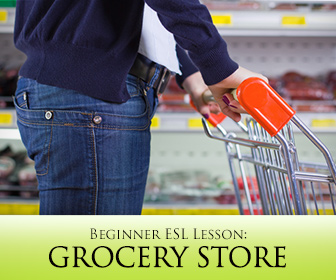A beginner lesson perfect for a class full of young, tactile-oriented learners who love to get up and move around.
This lesson aims at teaching and developing proper question phrasing as well as counting and using numbers.

Lesson Goals:
- Properly using the phrases, “Do you have…” “Where is the….” “How much is…”
- Identifying singular and plural nouns
- Recognizing countables and uncountables
- Follow up writing activity

Preparation:
To prep for this lesson, you will need to spend a little time in the days leading up to it creating a dozen or so food items that will serve as the items in your mock store. I was able to do this pretty quickly and easily using stock images and drawing from the web.
If you don’t have access to a colored printer, that’s okay—coloring in the pictures only takes a moment. You can even ask your students to do it. After you’ve colored your items, consider laminating them so you can reuse them later. I used the “food” from this lesson several more times during the year, for a variety of other games and activities.
You will also want to cut out small rectangular placards and mark them with prices. These placards will be placed in front of the food so that your student “shoppers” know how much they will need to pay to purchase an item. If you want, you can even create fake paper money (or buy some from a toy store), but the lesson works just fine without it.

How to Make it Effective
-
1
Step One: Setting Up
You will want to frame this lesson as a reward for your student’s hard work. At the beginning of the class unit on food, I told my students that we’d be able to our very own “store” at the end of the week. This news was immensely exciting for them, and created an incentive for them to participate throughout the course of the unit.
On the day of the lesson, you’ll want rearrange the furniture in your classroom so that a few tables serve as the “shelves” of the supermarket. You’ll also want to prep the board with any vocabulary words that your class has been practicing during the week leading up to the lesson. My board looked a little like this:
Questions
- Do you have _________? -----------> Countable? Add S! Uncountable? No S!
- Where is the/are the ________?
- How much is the/are the ________?
Vocabulary
- Bread
- Apple
- Orange
- Banana
- Meat
- Milk
- Orange Juice
- Carrot
- Broccoli
As the class starts, welcome your students to your grocery store. I came up with a silly name that incorporated the name of the school (which got a few giggles from my students). Before you start shopping, take the opportunity to review the vocabulary you’ve been covering. Once this has been done and you’re sure that all of your students are on the same page, move on to step two.
-
2
Step Two: Application and Practice
Select a two or three students to be ‘shoppers’. Once you’ve chosen your ‘shoppers’, give them each a shopping list. Next, have them enter the ‘store’. You will now assume the role of the supermarket employee. Engage the students in conversations that cover the target phrases you covered in the unit, correcting errors as you go. The students will then select the items on their grocery list, bring them back to you and pretend to purchase them. Go through this process with the whole class, perhaps repeating (if time allows).
-
3
Step Three: Reinforcement and Additional Learning
I usually like to follow up this lesson with a quick writing/drawing assignment. The assignment can either be done during class (if you have time) or for homework. Pass out a piece of paper to each student. At the top of the piece of paper, there should be a large, empty, rectangular box. Below the box, there should be several blank lines. Tell your students that you want them to draw a picture of the time they spent in the imaginary store and accompany it with a few sentences about what they did there.
For very young learners, consider having example sentences on the board for them to use to structure their own writing. For example:
- Today I went to the ________ store. It was _______! I even talked to the worker/employee! I said, “________________________________”. Then he/she said, “___________________________”. It was a _________ day.
Remember, any of these steps can be adjusted to shift the focus of the lesson from one thing to another. For example, if the emphasis is on money and counting, consider using items you already have lying around the classroom instead of cutting out and laminating pictures of food.
P.S. If you enjoyed this article, please help spread it by clicking one of those sharing buttons below. And if you are interested in more, you should follow our Facebook page where we share more about creative, non-boring ways to teach English.







